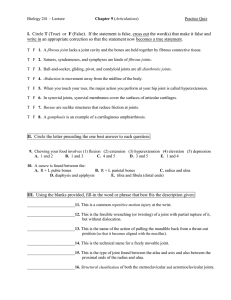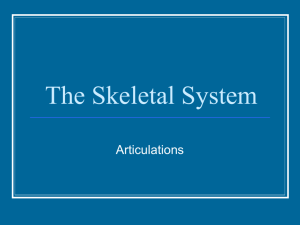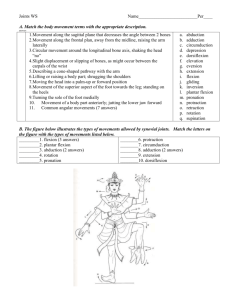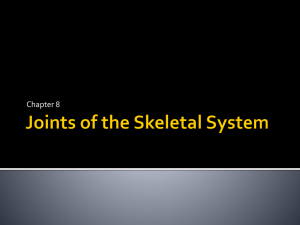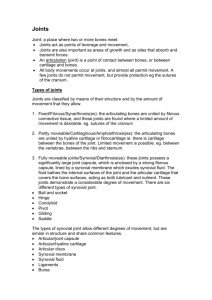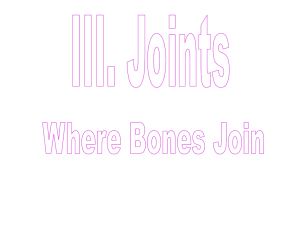Joints & Articulations: Types, Structure, and Movement
advertisement
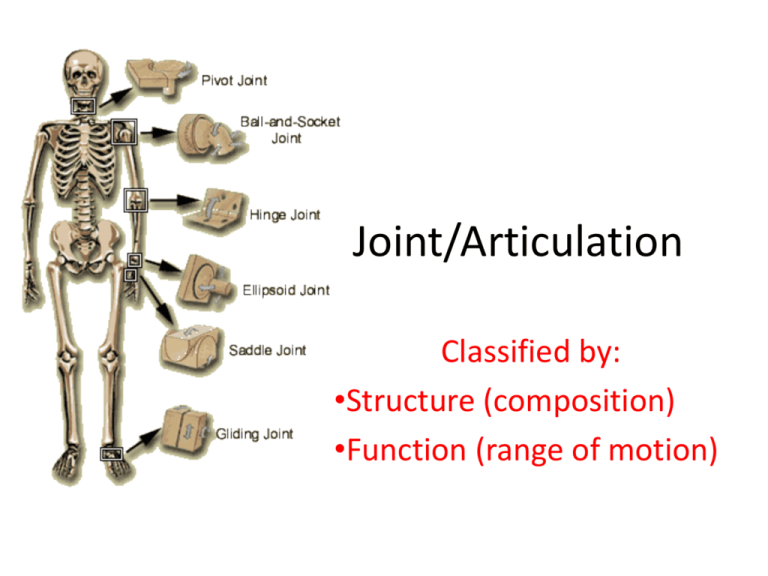
Joint/Articulation Classified by: •Structure (composition) •Function (range of motion) Types of Joints • Synarthosis – – Immovable Joints; usually joined by strong fibers – No joint cavity • Examples: sutures, joint binding tooth to socket, growth plate • • • • • Examples: Cartilage Amphiarthrosis Vertebra Discs, Pubic Symphysis No joint cavity Slightly movable joint Composed of fibrous joints Composed of cartilage joints Example: Fibrous – Membrane between radius and ulna Diarthrosis/Synovial Joint •Greater range of motion •Joint cavity is present •Contains synovial fluid • Six General Characteristics – Articular Cartilage • Covered with hyaline cartilage – Joint Cavity • Space filled with synovial fluid – Articular capsule • Fibrous capsule found on the periosteum of long bones – Synovial fluid • Viscous fluid contains macrophages • lubricates – Reinforcing ligaments – Fat Pads • Extra padding Types of Synovial Joints Pivot Joints • Allows for rotation • One bone rotates around another Examples Atlas and axis; Radius and ulna Examples: knee and elbow, phalanges Hinge Joints • One bone fits into another • Motion is along a single plane Ball and Socket • Freely moving joint • Head of bone articulates with fossa of another Examples: glenoid fossa and humerous; acetabulum and femur Gliding • Bones slide across one another • Bones must have flattened or curved faces to glide • Movement is limited Examples: carpals, tarsals, between vertebra Saddle • Shape resembles saddle • Permits angular motion; including circumduction but not rotation Examples: Thumb Types of Movement Gliding- two or more bones slide past each other • Rotation – turning around the longitudinal axis of body – Pronation and supination are a form of rotation • Pronation- turn palms posterior • Supination – turn palms anterior (Anatomical position) • Terms only apply to movement of radius Angular Movements -decrease or increase the angle between two bones • Flexion – decreases the angle between two bones • Extension – increases the angle between two bones • Hyperextension – increase the angle by > 180° Angular Movements flexion, extension, adduction, abduction and circumduction • Abduction – move away from body’s midline – To be abducted • Adduction – move toward body’s midline – Add to body • Circumduction – coneshaped movement • Dorsiflexion – point the toe up (superior) • Plantar flexion – point the toe down (inferior) • Eversion – turn ankle laterally • Inversion- turn ankle medially (most common way to twist ankle) • Protraction- move body part anteriorly • Retraction- move body part posteriorly Elevation – movement of the body superiorly Depression – movement of the body inferiorly
